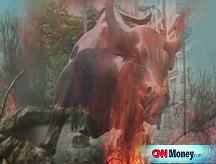The Fed: Life after zero
With rates about as low as they can go, Fed policymakers won't be talking about more cuts at their next meeting. Here's what they should be discussing instead.
NEW YORK (CNNMoney.com) -- The Federal Reserve has a two-day meeting next week to discuss what to do with interest rates. That's two days more than the central bank needs.
With the Fed having already cut its key interest rate to near zero last month, there is little suspense about what the central bank's Federal Open Market Committee will announce at the conclusion of its meeting on Wednesday, Jan. 28.
In fact, the Fed said in its statement last month that it would likely keep rates near zero "for some time" due to the weakness in the economy.
Still, the rate-setting FOMC, which includes Fed governors and a selection of the presidents from the Fed's twelve district banks, is set to meet eight times this year. And while the Fed probably has more tricks up its sleeve to help the economy, don't expect them to be announced Wednesday.
"I think the Fed always has bullets left, but as a practical matter, the FOMC can disband," quipped Sung Won Sohn, economics professor at Cal State University Channel Islands. "There's not a whole lot they can do right now. "
Of course, the Fed has been unusually creative in the past year. It has established several new programs to pump more than $1 trillion into the economy in an effort to help spur the economy and get banks to start lending again.
But most of these initiatives were approved by the Fed's Board of Governors, not the FOMC. And it's quite likely that even if the Fed comes up with new programs to try to help get credit flowing again, they also won't need the approval of the FOMC.
With that in mind, the Fed provided some hints last month about what to expect at future FOMC meetings. A senior Fed official told reporters that the FOMC would continue to meet on its regular schedule, and it would provide statement's about the central bank's view of the state of economy.
The official said the FOMC would also work in conjunction with the Fed's board of governors on decisions about the Fed's balance sheet, which has ballooned in the past few months due to the various new lending programs.
So once the FOMC is ready to start raising rates again, it may want to see the balance shrink in size by having some of these programs wind down.
The district presidents on the FOMC are also important because they act as the Fed's eyes and ears to banks and businesses throughout the country. Given the economic crisis, former Fed governor Lyle Gramley, who is now an economist with the Stanford Group, said it's more important than ever to have the FOMC discussing policy changes.
"Until we get clear evidence that the economy is turning around, things are going to stay very hectic at the Fed," he said.
Other economists say its clear that Fed Chairman Ben Bernanke wants to keep the Fed's district banks involved in various programs, such as the soon-to-be-implemented plan to back $200 billion in consumer and business loans.
It's also important to have the Fed speaking with one voice on the need for action, rather than having Fed presidents roaming the country criticizing actions by the Fed's governors.
"The fact that the board can do these things without consulting with the bank presidents doesn't mean they should do it that way," said David Wyss, chief economist for Standard & Poor's. "They want to make sure everyone is reasonably informed, but also that there is a consensus that they're doing it right."
Few expect any new program to be announced at the conclusion of its meeting next Wednesday. Instead, economists will be looking at the language in the Fed's statement for clues the Fed might send about its next policy step.
"At some point, it seems that they'll have to offer a clearer view of what comes next," said Tom Schlesinger, executive director of the Financial Markets Center, a think tank that follows the Fed.
For example, Wyss said that if the Fed includes a mention of the problem caused by troubled assets now held by banks, it will be taken as a signal that the Fed is close to announcing a so-called "bad bank" program to purchase toxic assets.
But Wyss cautions that despite the attention every word and comma in the statement is likely to receive, there probably will be far less concrete information than hoped for by economists and investors.
"People will be picking [the statement] apart because they don't have anything else to analyze," said Wyss. "But that doesn't mean they'll learn anything." ![]()




